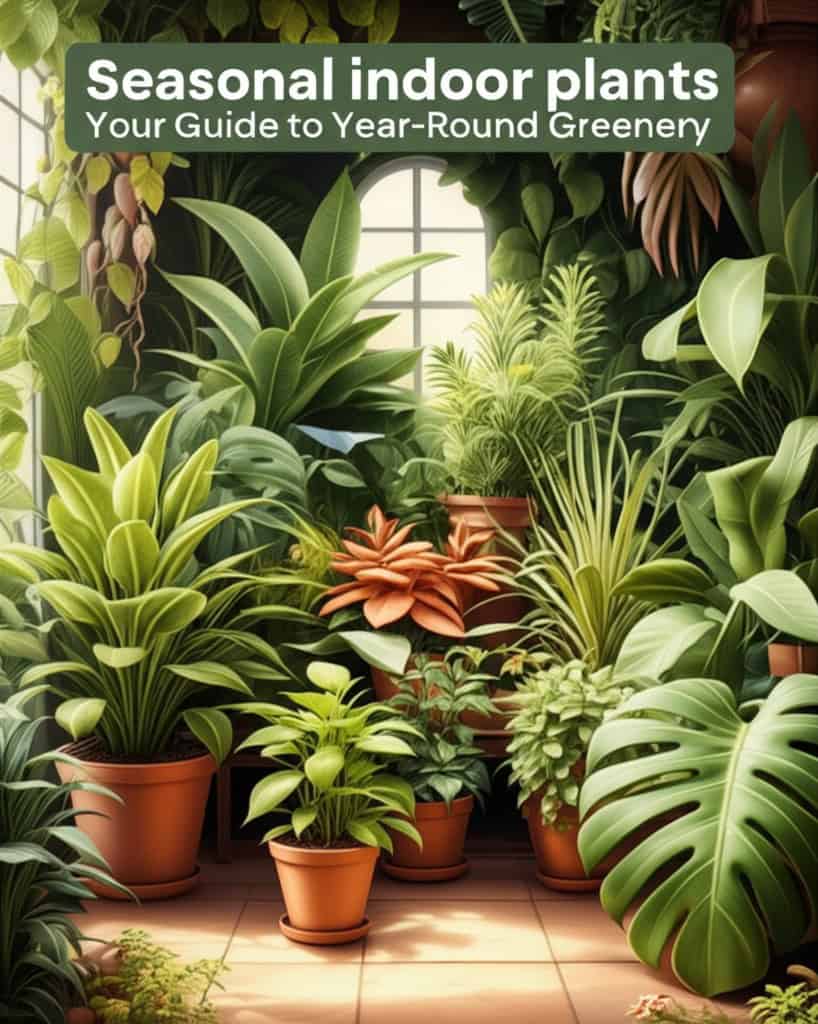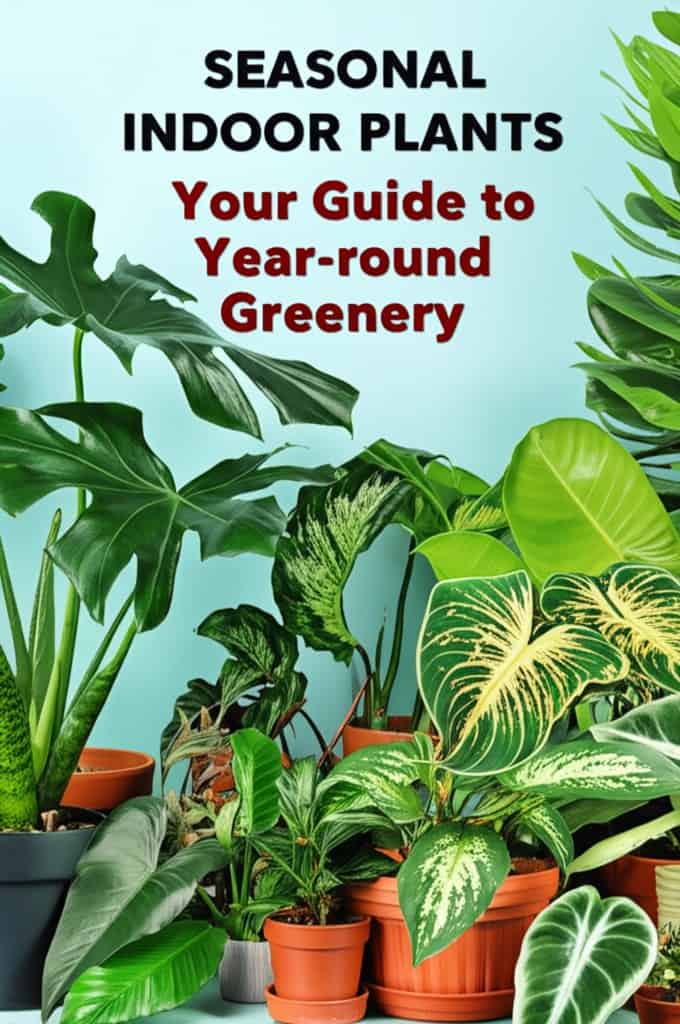
Transform your home into a year-round oasis with this comprehensive guide to seasonal indoor plants. Learn how to choose, care for, and display plants that thrive in every season, bringing beauty and vibrancy to your living spaces.
Key Takeaways
-
Embrace Temporary Décor: Most flowering houseplants bloom for short periods.
-
Add Winter Color: Brighten your home with winter bloomers like Christmas cactus, amaryllis, and cyclamen, which provide vibrant color when outdoor gardens are dormant.
-
Adjust Light: In winter, move light-loving plants like succulents closer to south-facing windows (which receive the most sunlight), or use grow lights. Low-light plants like snake plants can tolerate less direct light.
-
Reduce Watering: Watering should decrease in fall and winter as plant metabolism slows.
-
Propagate in Spring: Spring and early summer are ideal times for propagating indoor plants, such as pothos and snake plants.
-
Use Holiday Plants: Seasonal plants like poinsettias and Norfolk pines double as holiday decorations
Understanding Seasonal Indoor Plants

Seasons change, and so do our plants. The light shifts, the air dries out, and your green friends need different care. Most people miss this. They water the same way in December as they did in July—then wonder why leaves turn yellow and drop.
Indoor plants don’t hibernate, but they slow down. Their growth patterns shift with the seasons even when they’re protected from snow and wind. The fiddle leaf fig that shot up all summer might barely grow an inch during the winter months. This isn’t failure—it’s nature’s rhythm playing out on your windowsill.
Some plants are specifically tied to certain seasons. The Christmas cactus (Zygocactus) blooms right around the holidays, while paperwhites force their intensely fragrant, star-shaped flowers in winter’s darkness. These plants have internal clocks that tick regardless of your home’s constant temperature.
Winter Flowering Houseplants
Winter doesn’t mean the end of flowers. Some plants save their blooms for the darkest days—a middle finger to winter’s gloom.
The Christmas cactus drops its pink and red blooms right when you need color most. Amaryllis produces impressive, tall stalks topped with large, trumpet-shaped flowers in vibrant shades from pure white to deep crimson, often with striking patterns. Kalanchoe and Peace Lily offer bright blooms and interesting foliage through the coldest months.
African violets don’t care what month it is! These small powerhouses cycle through flowering periods with short rests between. Their round purple, pink, white, or blue flowers appear almost year-round with minimal effort. They thrive in bright, indirect light and prefer to be watered from the bottom. Their velvety leaves and vibrant blooms make them perfect examples of houseplants that bring a touch of spring to winter days.
For fragrance, paperwhites deliver a sweet perfume that fills rooms. Their white star-shaped blooms emerge from bulbs that need nothing more than water and light to perform their winter magic.
Spring and Summer Indoor Bloomers
When light returns, a new cast of characters takes center stage. Anthuriums push their waxy heart-shaped leaves in red, pink, or white. The moonflower (Spathiphyllum) unfurls white-glazed spathes that last for months.
Kalanchoe blossfeldiana is a low-maintenance succulent that produces clusters of vibrant, tiny flowers in shades of red, pink, orange, yellow, or white. These blooms can last for weeks, and the plant is remarkably drought-tolerant, making it ideal for forgetful waterers.
The shrimp plant (Justicia brandegeeana) is weird and wonderful. Its flower spikes look like pink and yellow crustaceans hanging from stems. Not common in every shop, but worth hunting down for year-round color.
Seasonal Care Adjustments
Plants aren’t stupid. They know when days shorten and light weakens. You should know too.
In summer, plants generally need more water. Succulents prefer the soil to dry out completely between waterings, while tropical plants like to stay consistently moist. Check the soil moisture by inserting your finger about an inch deep. If it feels dry, it’s time to water. Water thoroughly until water drains from the bottom of the pot, but don’t let the plant sit in standing water. In fall, gradually reduce watering frequency. For example, if you were watering twice a week in summer, reduce it to once a week or every ten days in fall. Observe your plants for signs of overwatering (yellowing leaves, mushy stems) or underwatering (drooping leaves, dry soil). Adjust your watering schedule accordingly.
Light changes dramatically with seasons. That perfect spot by the window in June might be too dark by November. Move plants to southern exposures in winter or supplement natural light with grow lights. LED grow lights are energy-efficient and come in various spectrums to support plant growth. Rotate plants regularly (about once a week) so all sides get equal light, preventing them from leaning towards the light source and ensuring even growth.
Fertilizer follows the same pattern. Feed actively growing plants in spring and summer, then cut back or stop completely in fall and winter. Plants at rest don’t need the extra nutrients and can burn from too much feeding.
Propagating During Optimal Seasons
Plants have preferences about when they multiply. Spring and early summer win for most propagation projects.
Take stem cuttings when plants actively grow. A snip of pothos or philodendron placed in water roots faster in April than October. The plant’s natural growth hormones flow stronger in growing seasons.
Division works best before growth spurts begin. To divide, gently separate the root ball of an overgrown plant in late winter or early spring, ensuring each section has roots and foliage. This gives them a full season to recover and establish.
Leaf cuttings from plants like African violets root readily in spring’s increasing light. A single leaf can spawn multiple new plants when conditions align with the plant’s biological clock.
Propagating Through Air Layering: This method encourages rooting on a stem while it’s still attached to the parent plant, ideal for plants with thick stems, like Ficus. To air layer, make a small cut halfway through the stem, wrap the cut area with moist sphagnum moss, and cover the moss with plastic wrap. Secure the plastic wrap with tape or ties. Once roots appear through the moss (usually in a few weeks), cut the stem below the roots and pot the new plant.
Propagating with Offsets: Some plants, like snake plants, produce small ‘pups’ or offsets that can be separated and repotted.
Propagating Rhizomes: Plants with rhizomes, like ZZ plants, can be propagated by dividing the rhizomes.
Seasonal Plant Varieties Worth Exploring
Beyond the common seasonal bloomers, there are some spectacular varieties worth adding to your collection. The Philodendron Silver Stripe offers stunning variegated foliage that develops more pronounced silver markings in brighter seasons. For something truly exotic, the Philodendron Mayoi brings palm-like leaves that create tropical vibes year-round.
Creating a Year-Round Display Plan
The secret to a constantly vibrant indoor garden is planning your displays around seasonal performers. Create a rotation schedule that ensures something is always in bloom or looking its best.
-
Winter (December-February): Feature Christmas cactus, cyclamen, amaryllis, and poinsettias in prominent positions.
-
Spring (March-May): Transition to calla lilies, peace lilies, and African violets.
-
Summer (June-August): Showcase flowering plants that love humidity, like anthuriums and orchids.
-
Fall (September-November): Highlight plants with colorful foliage as they prepare for dormancy.
By planning your displays seasonally, you’ll always have something spectacular to enjoy regardless of the month.
References
-
Royal Horticultural Society (RHS): “Beautiful winter houseplants and how to care for them” https://www.rhs.org.uk/plants/types/houseplants/winter-interest-houseplants-care
-
National Garden Bureau, “9 Winter-Blooming Houseplants to Brighten Your Home” https://ngb.org/9-winter-blooming-houseplants/
-
University of Maryland Extension, “7 Cheery Blooming Houseplants to Help You Beat the Winter Blues,” https://marylandgrows.umd.edu/2018/01/24/7-cheery-blooming-houseplants-to-help-you-beat-the-winter-blues/
-
Oklahoma State University Extension, “How to transition potted plants indoors for winter” https://extension.okstate.edu/articles/2021/indoor-plants.html
-
Longwood Gardens: “Winter is for Houseplants” https://longwoodgardens.org/blog/2024-01-17/winter-houseplants
-
Mississippi State University Extension Service, “Holiday Houseplants,” http://extension.msstate.edu/publications/holiday-houseplants-0
-
Ambius: “The Ultimate Guide To Indoor Plants” https://www.ambius.com/resources/blog/plant-profile/the-ultimate-guide-to-indoor-plants
-
Give Me Trees, “10 Flowering Plants to Grow at Home During Winters,” https://www.givemetrees.org/blogs/10-flowering-plants-to-grow-at-home-during-winters.php
-
Understanding Seasonal Indoor Plants: Ambius: “The Ultimate Guide To Indoor Plants” https://www.ambius.com/resources/blog/plant-profile/the-ultimate-guide-to-indoor-plants
-
Spring and Summer Indoor Bloomers: National Garden Bureau, “9 Winter-Blooming Houseplants to Brighten Your Home” https://ngb.org/9-winter-blooming-houseplants/
-
Seasonal Care Adjustments: Oklahoma State University Extension, “How to transition potted plants indoors for winter” https://extension.okstate.edu/articles/2021/indoor-plants.html
-
Propagating During Optimal Seasons: University of Maryland Extension, “7 Cheery Blooming Houseplants to Help You Beat the Winter Blues,” https://marylandgrows.umd.edu/2018/01/24/7-cheery-blooming-houseplants-to-help-you-beat-the-winter-blues/